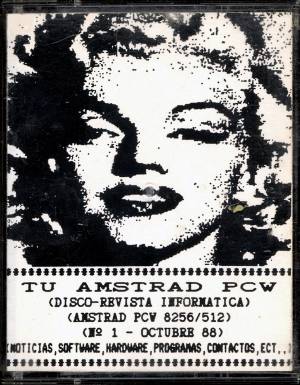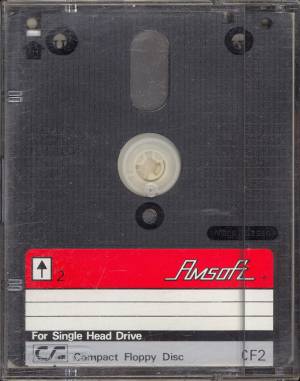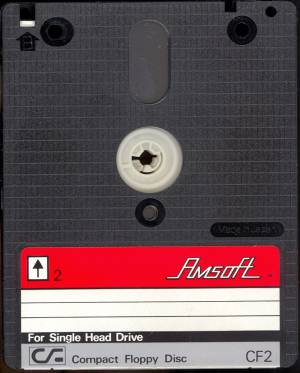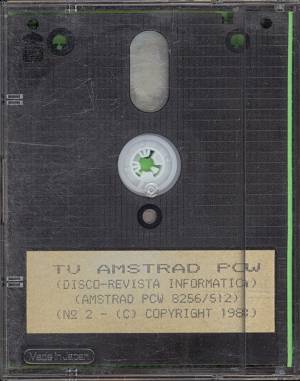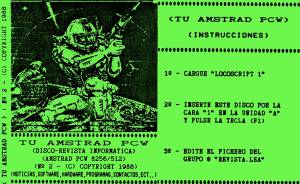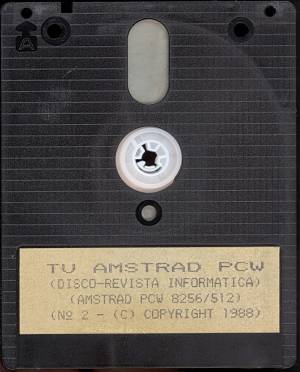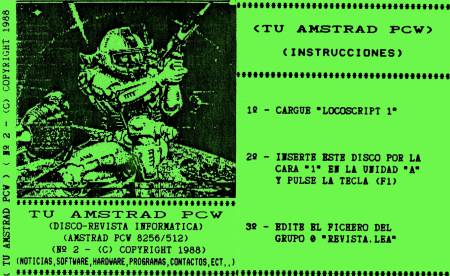Table of Contents
Tu Amstrad PCW
Info
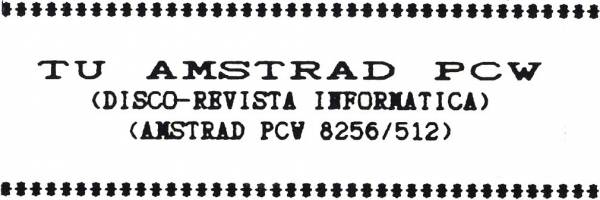 |
|
|---|---|
| Editorial | Tu Amstrad PCW |
| Distributor | Tu Amstrad PCW |
| Year | 1988-1988 |
| Gender | Disc computer magazine |
| Language | Spanish |
| Price | 795 Pesetas |
| Status | Preserved |
Description
Your Amstrad PCW is the first Computer Disc-Magazine in electronic format dedicated exclusively to users of the Amstrad PCW 8256 and 8512 range of computers. It was born in October 1988 with its first issue. Its launch only consisted of two numbers, since due to the low acceptance of the magazine, which depended on the users of a PCW, it did not continue with its publication.
It was sold in 3“ disc format, which, unlike paper magazines, once read, ended up in the trash, and with the disc format, it was thought that once read, the disc could be formatted on both sides (A and B) at any time, obtaining an additional disk and savings.
The magazine was contained on a double-sided, single-density CF2 disc recorded on both sides that was retrievable by simply being reformatted to single or double density. The disk was compatible with Amstrad computers in the full PCW 8256 and 8512 range. No professional software was needed to process it, just the system disk that came with the original computer: Locoscript, CP/M, Utilities, Logo , etc.
It was born out of the tragic and unfair situation in the PCW world and with the decision to try to avoid the accumulation of the ingredients that were creating the death certificate of a great team. The idea arises, when the sales of the Amstrad PCW's were doubled by the users, more than the purchases.
It had a very clear objective: to create an exclusive information service at the service of PCW users: News, Hardware, Contacts, Software, Tricks, Programs, Graphics, Services, etc. Elements all of them that allow month to month to improve the knowledge and use of your computer system. They gradually offered, with the support and help of PCW users, the best service to the PCW world.
It allowed to visualize and print any article and without having to type the heavy and fantastic programs that it included, since they were already copied and debugged. They also allowed the display of photos and graphics and best of all, lacked massive advertising.
It provided the novelty of a novel format on disk, which allowed great advantages, previously impossible, for the PCW user in facets such as; comfort, performance and economy.
He did not want to be a competition for the other printed magazines (although this one is beneficial for the computer world) because practically nobody had taken care of the PCW world that was destined to disappear. The PCW`s park was humble compared to other models.
- The front cover was 16.40 cm long by 10.10 cm high.
Collection
Number 1 - October 1988
Side A contains the magazine itself and side B consists of the files with the gift programs and digitized photographs.
SIDE A
It is based on text files in Locoscript format. In order to view and process the information, you must follow the instructions below:
- 1st Load the LocoScript 1 word processor (System Disk 1 (SIDE A)).
- 2nd Insert side A into the upper unit and press (f1) to notify the program that the disk has been changed and update the file management screen.
- 3º Now you will be able to appreciate the general structuring of the magazine- The different groups contain files on the different sections of the magazine: editorial, instructions, news, hardware, contacts, software, services, programs, graphics, etc.
SIDE B
This contains the files of the programs they gave away. The files can have different extensions (.COM, .BAS, .PAS, etc…). You can view and print the description, installation and operating instructions for each program by operating on the files in the “Programs” group on Side (A).
Additionally, you will find files with the extension (.PIC), which correspond to diagrams, graphs and digitized photographs that are viewable and printable without the need for professional software.
On this face there are 3 files with the extension .PIC. Its content is as follows:
- Z88.PIC —> Corresponds to a digitized photograph of the “Cambridge Z88” super portable computer.
- MARILIN.PIC —> Corresponds to a digitized photograph of the famous star.
- PANTALLA.PIC —> Corresponds to the digitized graphic design of spatial design.
Other content:
- DISCO.COM —> Utility through which we can compress/decompress files.
- CLS.COM —> Compiled utility used to clear the screen.
- ROMBO.COM —> Compiled file (rombo.bas) that generates a graph
- MULTIPLE.COM —> Compiled file (multiple.bas) that generates 10 different three-dimensional graphics.
- LOTO.BAS —> Program in Mallard Basic that generates random combinations for the primitive lottery.
- WESTEND.BAS —> Mallard Basic program that replaces the display character set with a new one.
- INFOBIOS.BAS —> Program in Mallard Basic that informs the user about the BIOS, checking the PCW.
- ROMBO.BAS —> Source code in CBasic that generates a graph
- MULTIPLE.BAS —> Source code in CBasic that generates 10 different three-dimensional graphics.
Number 2 - November 1988
Side A contains the magazine itself and side B consists of the files with the gift programs and digitized photographs.
CARA A
It is based on text files in Locoscript format. In order to view and process the information, you must follow the instructions below:
- 1st Load the LocoScript 1 word processor (System Disk 1 (SIDE A)).
- 2nd Insert side A into the upper unit and press (f1) to notify the program that the disk has been changed and update the file management screen.
- 3º Now you will be able to appreciate the general structuring of the magazine- The different groups contain files on the different sections of the magazine: editorial, instructions, news, hardware, contacts, software, services, programs, graphics, etc.
SIDE B
This contains the files of the programs they gave away. The files can have different extensions (.COM, .BAS, .PAS, etc…). You can view and print the description, installation and operating instructions for each program by operating on the files in the “Programs” group on Side (A).
Additionally, you will find files with the extension (.PIC), which correspond to diagrams, graphs and digitized photographs that are viewable and printable without the need for professional software.
On this face there are 3 files with the extension .PIC. Its content is as follows:
- PORTADA.PIC —> The digitized photograph of the cover in enlarged mode.
- NUMERO7.PIC —> A wonderful digitization of the famous robot number 7.
- NASA.PIC —> NASA's impressive image of man in space.
Other content:
- DIBUJO.BAS —> Phenomenal program in Mallard Basic, which allows us to draw on the screen and capture images.
- RELOJCPM.BAS —> Utility written in Mallard Basic that allows us to read the internal clock of the CP/M.
- FLASH.BAS —> A great program written in Mallard Basic that allows other programs to get great effects,
- SERIF.BAS —> Program in Mallard Basic that replaces the character set on the screen with a new one.
- CREDITOS.BAS —> A useful Mallard Basic program that calculates bank credits.
- CONTADOR.ASM —> Assembler listing of the program counter.com.
- CONTADOR.COM —> Compiled program whose function is to count the words that make up a given file.
- TECLAS.COM —> Simple and useful compiled program that detects the pressing of a key returning its ASCII.
- GRAFICOS.COM —> Program compiled in CBasic, which allows graphic design on screen.
- ACENTOS.ESP —> Mini program that allows you to obtain accents in Mallard Basic.

